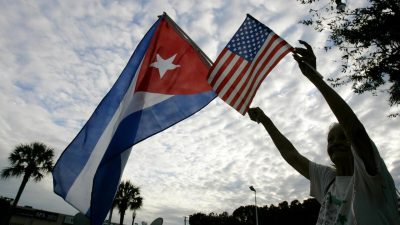A Cuban Mystery: The US Embassy in Havana

Cuba has, for decades, been a form of political pathology for US political consciousness. Fidel Castro loomed in his indestructible guise, tormenting a succession of American presidents with his seeming indestructibility. Efforts at deposing and assassination had conspicuously failed. It was left, then, to Washington to insulate, seal off and keep Cuba as an infectious patient of international relations, fearing its global reach and influence.
With the softening of this manic stance under the Obama administration, Cuba ceased being the incurable. It even had promise. US business officials were smacking their lips and rubbing hands. The new Cuba might well return to the Cuba of old, one more open to reverie, smut and cash. The diplomats would return; the US embassy would reopen in Havana.
Then, Donald Trump happened. A new administration, the government of 140 character messages, roars and expectoration. The cool seemed likely to return in the heat of intolerance and misguided encounters. In June, Trump announced that limitations on trade and tourism with Havana would be imposed. It was a corrective of sorts to yet another “one-sided deal” and halted people-to-people exchanges.
Since the fall of 2016, staff at the US embassy have been troubled. Up to 21 diplomats have been affected by what is now being considered an attack. (These had been previously deemed, in State Department speak, “incidents”.) American media outlets, from the Old Grey Lady onwards are unanimous.
“It started as a medical mystery,” went the New York Times. “It then was determined to have been the result of a mysterious attack.”
The symptoms cover a considerable range: nausea, dizziness, tinnitus, difficulty with sleeping, deafness, even mild brain trauma. That these might have arisen from a sonic attack has been suggested. But speculation is rife as the coterie of experts in the field of bio-electromagnetics are entertained. What sort of weapons might have been behind this?
One such figure is Denis Bedat, who made his splash for the AFP new agency.
“Ultrasonic waves, beyond the acoustic capacity of humans, can be broadcast with an amplifier, and the device does not need to be large, or used inside or outside the house.”[1]
Weapons such as the anti-riot gun in the employ of the US police forces, otherwise known as the Active Denial System (ADS), are exponents of such waves.
The Secretary of State Rex W. Tillerson has been cautious in according blame, despite also pouring over a proposed plan to close the embassy in Havana.
“We have it under evaluation. It’s a very serious issue with respect to the harm that certain individuals have suffered. We’ve brought some of those people home. It’s under review.”[2]
Havana, in turn, has urged caution and restraint, expressing official bafflement at the cases.
“Cuba has told us it will continue to investigate these attacks, and we will continue to cooperate with them in this effort.”
This policy of cooperation is typically troubled, an appellation of suspicion and masochism.
Given that two Cuban diplomats have suffered expulsion as a result, the finger pointing is being presumed, even if those fingers are slightly askew. Punish, but not abolish; tell those in Havana that this is not the sort of thing the US will tolerate, but still keep doors open, if only slightly ajar and barely operating.
On Friday, the State Department did announce a suspension of routine visa operations, giving no clue when they would resume, while limiting official travel to Cuba by US officials, excepting those connected with the investigation or those in need of travelling to the country.[3]
The sting in the tail, however, was a travel warning for Americans in general, suggesting danger to visitors from the US. As “our personnel’s safety is at risk, and we are unable to identify the source of the attacks, we believe US citizens may also be at risk and warn them not to travel to Cuba.”[4]
Tillerson is exercising caution, and the theory that a third party may well be up to mischief is being floated. Officials have spoken about taking measures of protection in the name of prudence. Ambassador Barbara Stephenson, president of the American Foreign Service Association, has expressed concern that the US is prizing itself out of the diplomatic game in taking them.
“We’ve got a mission to do,” she explained to The Atlantic. “We operate all over the world, in places with serious health risks… The answer can’t be we just pull the flag down and move American presence from the field.”[5]
Havana has expressed consternation at the moves by the Trump administration, but is still hopeful in cooperation. But all this signals, yet again, the odd mix of machismo mixed with caution; bluster with a U-turn and summersault in Trump’s version of foreign policy.
Dr. Binoy Kampmark was a Commonwealth Scholar at Selwyn College, Cambridge. He lectures at RMIT University, Melbourne. Email: [email protected]
Notes

